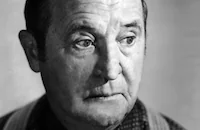Nancy Drew and the Hidden Staircase

Brief Synopsis
Cast & Crew
William Clemens
Bonita Granville
Frankie Thomas
John Litel
Frank Orth
Renie Riano
Film Details
Technical Specs

Synopsis
Mayhem erupts when teenager Nancy Drew convinces the elderly Turnbull sisters to give their estate to a children's hospital. Under the provisions of their father's will, the sisters must live in the mansion for twenty years or the property will go to the city. Two weeks before the twenty-year term has elapsed, a gangster appears at the Drew house and demands the affidavits proving the sister's residency, but he is thwarted by Nancy's boyfriend, Ted Nickerson. Soon afterward, the Turnbull chauffeur, Phillips, is found dead, and the terrified sisters threaten to move out of their house. To allay their fears, Nancy fabricates a suicide note but recognizes Phillips as the gangster in search of the affidavits, leading her to suspect foul play. The sisters threaten to leave once again when a robbery occurs in their locked house, but Nancy persuades them to stay. Convinced that the robber entered through the basement, Nancy chides Ted into spending the night in the darkened cellar and sets up a camera to provide evidence of any intruders. That night, someone sneaks in and steals Ted's clothes, and when Nancy and Ted develop the negative the next day, they see a blurred figure moving toward the wall. The house seems lost to the hospital when Captain Tweedy arrests the sisters for Phillips' murder, but Nancy remains determined to find the real murderer. She and Ted discover a hidden doorway and tunnel leading to the house of Talbert, the Turnbull's neighbor, where they discover a plan for a racetrack that includes the Talbert and Turnbull house. Realizing that Talbert must have murdered Phillips to make certain that the sisters would lose their house and hence make his property lucrative for racetrack development, Nancy and Ted retreat to the tunnel, when they hear Talbert return. Tracing their muddy footprints, Talbert pursues them to the tunnel where they become trapped as the passageway begins to flood. In the ensuing scuffle, Nancy knocks Talbert unconscious with her shoe, and after the trio is rescued by the police, Talbert is arrested for murder.

Director
William Clemens
Cast

Bonita Granville

Frankie Thomas

John Litel

Frank Orth
Renie Riano
Vera Lewis
Louise Carter
William Gould
George Guhl

John Ridgely
Dewolf Hopper
Creighton Hale
Frank Mayo
Fred Tozere
Don Rowan
Dick Elliott
Nat Carr

Jack Mower
Edwin Parker
Frank Meredith
Psyche Neibert
Fern Barry
Cliff Saum
Crew
Milo Anderson
E. A. Brown
Hugh Cummings
Bryan Foy
Kenneth Gamet
Louis Hesse
Lee Huginin
L. William O'connell
Russ Saunders
Ted Smith
Jack L. Warner

Film Details
Technical Specs

Articles
Nancy Drew and the Hidden Staircase
The Nancy Drew films grew out of the popular juvenile book series aimed at young girls. The books were the brainchild of publisher Edward Stratemeyer, founder of the Stratemeyer Syndicate, with the first one, The Secret of the Old Clock, published in 1930. Stratemeyer outlined the first four Nancy Drew stories himself, but enlisted writer Mildred Wirt Benson to flesh them out into full manuscripts under the pen name Carolyn Keene. Stratemeyer's daughter, Harriet Stratemeyer Adams, then edited the completed books for final publication. They were an immediate sensation with young readers, and Warner Bros. snapped up the movie rights to the series in 1938.
Warner Bros. made its first Nancy Drew film, Nancy Drew Detective, in 1938 starring Bonita Granville as Nancy and Frankie Thomas as her boyfriend, Ted Nickerson. The low-budget film was originally intended as a B-movie second half of a double bill. However, it proved popular enough with audiences that the studio quickly cranked out three more in succession with the same cast and crew.
Nancy Drew and the Hidden Staircase was based on the second book in the Nancy Drew series, The Hidden Staircase. In fact, despite the abundance of original source material, Nancy Drew and the Hidden Staircase was the only one of the Warner Bros. films to actually take its story from one of the books, though significant changes were made by screenwriter Kenneth Gamet.
15-year-old former child actress Bonita Granville portrayed Nancy Drew in all four movies. She made a strong impression as the feisty girl detective, bringing charm and energy to the part. Earlier in her career, Granville had been nominated for an Academy Award for her performance in These Three (1936) as an attention-starved school girl who spreads devastating lies about her teachers. Nancy Drew and the Hidden Staircase was the last film Granville made at Warner Bros. before moving to MGM. It was the last time Nancy Drew appeared on the big screen.
Of all the films in the Nancy Drew series, Nancy Drew and the Hidden Staircase received the most favorable reviews. "Characters are all nicely cast and competent, including John Litel, as Bonita's father, and Frank Orth as the plucky police captain," said Variety. "Director William Clemens keeps the film moving at a speedy clip and gets in some nice comedy touches." Fast-paced and vibrant, Nancy Drew and the Hidden Staircase holds up surprisingly well today and captures the spirit of the original books, still thriving after 75 years.
Producer: Bryan Foy, Hal B. Wallis, Jack L. Warner
Director: William Clemens
Screenplay: Mildred Wirt Benson (story), Kenneth Gamet
Cinematography: L. William O'Connell
Film Editing: Louis Hesse
Art Direction: Ted Smith
Music: Heinz Roemheld
Cast: Bonita Granville (Nancy Drew), Frankie Thomas (Ted Nickerson), John Litel (Carson Drew), Frank Orth (Captain Tweedy), Renie Riano (Effie Schneider), Vera Lewis (Miss Rosemary Turnbull).
BW-60m.
by Andrea Passafiume

Nancy Drew and the Hidden Staircase
Quotes
Trivia
Notes
According to a news item in Hollywood Reporter, Noel Smith was originally scheduled to direct this picture. This was the last film in the "Nancy Drew" series, and Bonita Granville's last film at Warner Bros. before moving to M-G-M. For additional information about the series, consult the Series Index and for Nancy Drew, Detective.















